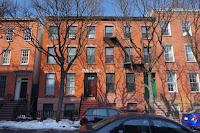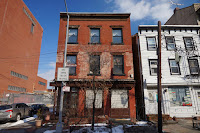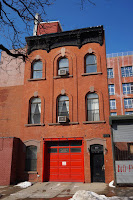 |
| Hudson Avenue |
Adjacent to a ConEdison Power Station and book-ended by Dumbo and the Brooklyn Navy Yard / Commandant’s House is the neighborhood of Vinegar Hill, a place that time forgot. My first encounter with the neighborhood was during a site visit to investigate the area for a potential bicycle greenway. I was struck by the quiet streets, and its anachronistic sense of place. Being there felt like I stepped back in time.
Much of what was Vinegar Hill was razed for the erection of the Brooklyn Queens Expressway and the Farragut Houses.[1] What remains of the historic buildings of Vinegar Hill are in the Vinegar Hill Historic District which includes three areas that define the neighborhood’s sense of place. The areas are mostly comprised of brick Italianate and Greek Revival style row houses built from the early to mid-nineteenth century, although there are structures built as late as 1908.[2][3]
 |
| Historic District Map |
|
|
||||
 |
 |
 |
 |
||
 |
 |
|
 |
 |
 |
 |
 |
 |
Vinegar Hill History:
Vinegar Hill’s original inhabitants were the Canarsi Indians. The first Europeans to visit the area, arriving in the early 17th century, were fur traders from England, the Netherlands and Sweden. After being weakened by war and European diseases, the Canarsees sold the land that makes up Vinegar Hill to the Dutch in 1637.[2]
The name Vinegar Hill was bestowed upon the neighborhood by one of the areas developers, John Jackson, in honor of an Irish-English battle. Jackson, a ship builder, owned a shipyard at the foot of Hudson Street and built housing for his workers in Vinegar Hill. The other early developer of the historic portion of Vinegar Hill was Joshua Sands. The Sands family had amassed their fortune as merchants and speculators. They began laying out their lots around 1787; although, the lots were not developed residentially until the mid-1830s to mid-1850s.[2]
Most of the neighborhood’s residents were comprised of laborers from local industry with a smaller percentage of commercial proprietors with businesses serving the community. The local industries included spice and coffee works, metal stamping, engine works, paint and varnish manufacturing, and sugar refining among others. Some of the early industries that started in the area are household names today, like Benjamin Moore and Durkee. The neighborhood’s historic commercial strips were located on Sands Street, Water Street and Hudson Street. The remnant clues to Hudson Street’s commercial past can still be seen in the fenestration of the streets’ buildings.[2] Although, the street is now quiet and residential most of the structures retain their store front windows. Hudson Street once traversed the neighborhood in a continuous route to Fulton Street and included an elevated train route until 1940.[1]
References:
- "Vinegar Hill" Forgotten NY
- New York City Landmarks Preservation Commission Designation Report Vinegar Hill Historic District 14 January, 1997.
- White, Norval, Willensky, Elliot, and Leadon, Fran AIA Guide to New York. Oxford University Press, 2010.







My father was born here in 1911. His father was a laborer at the local sugar mill who came from Lithuania in 1905 as a refugee of the first Russian Revolution.
ReplyDeleteMy mother was born at 311 Plymouth Street in 1939. Her father was a Crane Supervisor at the Brooklyn Navy Yard from 1932 to 1958. The house was torn down in the 1940s to make way for the expansion of the Con Edison company. I love this neighborhood and my mother is so happy whenever we return to see it. She has so many stories from being a child there. If anyone has any pictures of the house that formerly stood at 311 Plymouth Street please post them. Thank you very much.
ReplyDelete